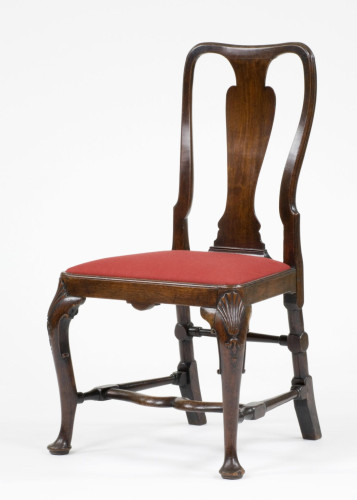18/2006
Collection
Furniture
Brief description
One of a set of four walnut India-back chairs with a vasiform splat and a drop-in seat with modern upholstery, manufactured in England c.1730.
Object name
chair
Object number
18/2006
Production date
c.1730 (manufactured)
Production place
England (manufactured)
Period
Georgian (1714-1837)
Material
walnut
textile
textile
Technique
joined
carved
moulded
turned
carved
moulded
turned
Physical description
Walnut chair with bended back and a slight dished top rail, waisted posts and a vase-shaped splat. The chair has a drop-in seat with modern upholstery in red camlet. The chair has moulded rails and cabriole forelegs (carved, double-curved, tapering leg) headed by a carved scallop shell. The legs are joined by turned side and back stretchers and a cupid’s bow medial stretcher. The chair is solid walnut throughout.
Both the joints to the top and rear posts are filled with slips of wood to tighten them up. The back seat rail is wormed and the wood is noticeably lighter in colour than the rest of the chair. There is evidence of staining on the outside of the seat rail to harmonise with the sapwood seat rail. The back rail is stamped WI [or L?] and on the inside it is marked with the Roman numeral 'I' and “1806 st”. The pegs have been replaced on the side rails, back posts and side stretchers. The joints between the rails and the tops of the forelegs have been filled. The brackets at the left side, right side and right front have been replaced, although the left front is apparently original. There is some wear to front feet which seems to have been caused by dragging the chair across the floor.
The drop-in seat is modern.
Both the joints to the top and rear posts are filled with slips of wood to tighten them up. The back seat rail is wormed and the wood is noticeably lighter in colour than the rest of the chair. There is evidence of staining on the outside of the seat rail to harmonise with the sapwood seat rail. The back rail is stamped WI [or L?] and on the inside it is marked with the Roman numeral 'I' and “1806 st”. The pegs have been replaced on the side rails, back posts and side stretchers. The joints between the rails and the tops of the forelegs have been filled. The brackets at the left side, right side and right front have been replaced, although the left front is apparently original. There is some wear to front feet which seems to have been caused by dragging the chair across the floor.
The drop-in seat is modern.
Dimensions
Height: 97.6cm
Width: 55.8cm
Depth: 41.8cm
Depth: 54cm
Width: 55.8cm
Depth: 41.8cm
Depth: 54cm
Website keywords
seating
Label
Label text for 1745 Period Room (Room 3), Geffrye Museum, 2010:
‘India-back’ chairs
Chairs of this type were described as ‘India-back’ at the time because the form of the back was adapted from Chinese chairs and the term ‘India’ was used as a general description for objects from Asia. Such chairs became the standard form of seating in middling parlours, replacing cane chairs. They were also often shown in portraits of the middling sort at this period, helping to convey the sitter’s polite credentials.
Walnut, modern upholstery, 1730s–1740s, replica upholstery in moreen
‘India-back’ chairs
Chairs of this type were described as ‘India-back’ at the time because the form of the back was adapted from Chinese chairs and the term ‘India’ was used as a general description for objects from Asia. Such chairs became the standard form of seating in middling parlours, replacing cane chairs. They were also often shown in portraits of the middling sort at this period, helping to convey the sitter’s polite credentials.
Walnut, modern upholstery, 1730s–1740s, replica upholstery in moreen














